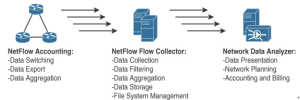PIM Source-Specific Multicast (PIM-SSM) is a variant of PIM-SM that builds trees that are rooted in just one source. SSM, defined in RFC 3569, eliminates the RPs and shared trees of sparse mode and only builds an SPT. SSM trees are built directly based on the receipt of group membership reports that request a given …
Category: Gigabit Ethernet Design Rules
Aug 20
IPv6 Multicast Addresses – IP Multicast and Network Management
IPv6 retains the use and function of multicast addresses as a major address class. IPv6 prefix FF00::/8 is allocated for all IPv6 multicast addresses. IPv6 multicast addresses are described in RFC 2373. The EIGRP for IPv6, OSPFv3, and RIPng routing protocols use multicast addresses to communicate between router neighbors. The format of the IPv6 multicast …
Mar 15
NetFlow 2 – IP Multicast and Network Management
The NetFlow export or transport mechanism sends the NetFlow data to a collection engine or network management collector. Flow collector engines perform data collection and filtering. They aggregate data from several devices and store the information. Different NetFlow data analyzers can be used, depending on the intended purpose. NetFlow data can be analyzed for the …
Jan 14
NetFlow – IP Multicast and Network Management
Cisco NetFlow enables tracking of IP flows as they are passed through routers and multilayer switches. An IP flow is a set of IP packets within a specific time slot that share a number of properties, such as the same source address, destination address, type of service, and protocol number. NetFlow information is forwarded to …
Nov 25
NetFlow Compared to RMON and SNMP – IP Multicast and Network Management
NetFlow enables you to gather more statistical information than RMON with fewer resources. It provides greater detail on the collected data, with date- and timestamping. NetFlow has greater scalability and does not require network probes. NetFlow reports on traffic statistics and is push based, whereas SNMP reports primarily on device statistics and is pull based. …
Aug 20
LLDP – IP Multicast and Network Management
Link Layer Discovery Protocol (LLDP), defined in the IEEE 802.1AB (LLDP) specification, is an option for discovering network devices in multivendor networks. LLDP performs functions similar to those of CDP. With LLDP, devices send information at a fixed interval from each of their interfaces in the form of an Ethernet frame with Ethertype 0x88CC. The …
Apr 25
10 Gigabit Ethernet Design Rules – Enterprise LAN Design and Technologies
The IEEE 802.3ae supplement to the 802.3 standard, published in August 2002, specifies the standard for 10 Gigabit Ethernet. It is defined for full-duplex operation over optical media, UTP, and copper. The IEEE 802.3an standard provides the specifications for running 10 Gigabit Ethernet over UTP cabling. Hubs or repeaters cannot be used because they operate …
Feb 20
EtherChannel – Enterprise LAN Design and Technologies
The Cisco EtherChannel implementations provide a method to increase the bandwidth between two systems by bundling Fast Ethernet, Gigabit Ethernet, or 10 Gigabit Ethernet links. When bundling Fast Ethernet links, use Fast EtherChannel. Gigabit EtherChannel bundles Gigabit Ethernet links. EtherChannel port bundles enable you to group multiple ports into a single logical transmission path between …
Nov 20
Comparison of Campus Media – Enterprise LAN Design and Technologies
As noted previously, several media types are used for campus networks. It is common to run UTP to end stations, use multiple multimode uplinks from access to distribution, and use single-mode fiber for longer-distance and higher-bandwidth links. Table 6-7 provides a summary comparison of these media. Table 6-7 Campus Transmission Media Comparison Factor Copper/UTP Multimode …
Feb 20
BPDU Filter – Enterprise LAN Design and Technologies
BPDU Filter prevents a port from sending or receiving BPDUs. It can be configured on a per-port basis. When configured globally, it applies to all operational PortFast ports. Explicitly configuring PortFast BPDU filtering on a port that is not connected to a host can result in bridging loops. If a port configuration is not set …
- 1
- 2



